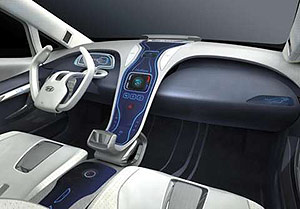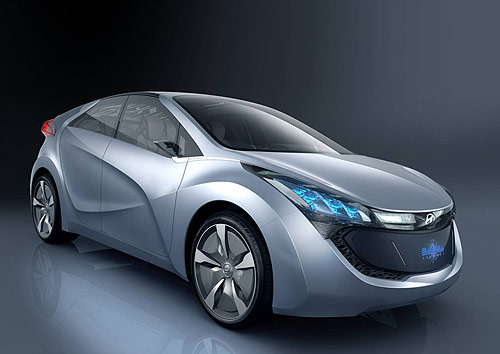 Meet the Hyundai Blue-Will Plug-in Hybrid … at 4,300mm in length and 1800mm in width this is not a small car but with a combined consumption rate 2.35L/100km it will deliver better fuel economy than the Fiesta Econetic. Although that sort of comparison is largely irrelevant because this is only a concept car and when it’s progeny hits the streets things are sure to be a lot different.
Meet the Hyundai Blue-Will Plug-in Hybrid … at 4,300mm in length and 1800mm in width this is not a small car but with a combined consumption rate 2.35L/100km it will deliver better fuel economy than the Fiesta Econetic. Although that sort of comparison is largely irrelevant because this is only a concept car and when it’s progeny hits the streets things are sure to be a lot different.
Blue-Will serves as a test-bed of new ideas, ranging from roof-mounted solar cells to drive-by-wire steering, lithium polymer batteries and touch-screen controls. It foreshadows future focused hybrid production vehicles from Hyundai, and promises an electric-only driving distance of up to 64.4 kilometres on a single charge with an amazing fuel economy rating of more than 2.35 litres per 100 km (42.5 km per litre).
“Blue-Will’s bold character lines and fluidic sculpture design language give the perfect expression to the advanced eco-friendly technologies found beneath the skin,” said Oh Suk-Geun, executive vice president of design, Hyundai Motor Company. “At a time of rising concern about the environment and our energy future, Blue-Will demonstrates to eco-conscious car buyers everywhere that Hyundai has practical hybrid solutions destined to appear on the next generation of vehicles.”
Blue-Will’s designers created the centre stack with a simple and clean look, incorporating high-tech touch-screen control technology. The focal point of this display is the revolutionary ‘Eco-Coach’, which promotes fuel-saving habits by providing continuous feedback on fuel consumption and driving efficiency.
Hybrid Blue Drive architecture powers an all-aluminium 113.3kW Direct Injected (GDI) 1.6-litre engine mated to a Continuously Variable Transmission (CVT). A 100kW electric motor is at the heart of Hyundai’s proprietary parallel hybrid drive architecture with wheels turned by power coming directly from the petrol engine, the electric motor, or both together, as conditions demand.
This parallel hybrid drive architecture serves as the foundation for future Hyundai hybrids.

Lithium polymer batteries can be recharged using household electricity. Hyundai was the first automaker in the world to apply this technology to mass production vehicles when the Elantra LPI Hybrid Electric Vehicle (HEV) went on sale in South Korea in the middle of last year.
Thermal Generator: energy-saving innovation allows energy from hot exhaust gases to be recaptured by an exhaust manifold fitted thermal generator, which then converts the heat into electrical energy helping power auxiliary systems. Low-rolling tyres and low-drag brakes further improve efficiencies along with brake pad and calliper treatments.
The Hyundai Blue-Will Plug-in Hybrid that you see here features drive-by-wire steering, ultra-thin transparent organic LED instrument cluster, touch-screen drive selector control and roof-mounted dye-sensitised solar cells.